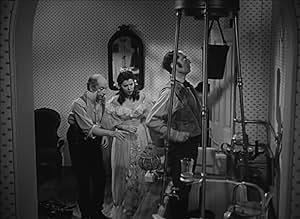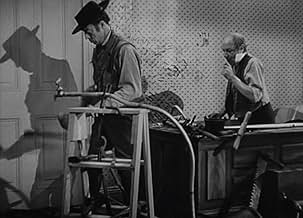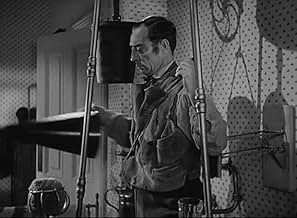Ajouter une intrigue dans votre langueDuring World War II, an American travels to Britain to sell an old house near London that belongs to his family. However, he meets Leslie Trimble who lives in the house and who is resolutely... Tout lireDuring World War II, an American travels to Britain to sell an old house near London that belongs to his family. However, he meets Leslie Trimble who lives in the house and who is resolutely against the sale. While they spend the night in an air-raid shelter she tells him the sto... Tout lireDuring World War II, an American travels to Britain to sell an old house near London that belongs to his family. However, he meets Leslie Trimble who lives in the house and who is resolutely against the sale. While they spend the night in an air-raid shelter she tells him the story of the building from its construction in 1804 until the present.
- Récompenses
- 1 victoire au total
- Wartime Londoner
- (as Doreen Monroe)
- Wartime Bus Conductor
- (as Joy Harrington)
Avis à la une
When the nightly German bombing raids throw the two together with many others from the neighborhood in the basement, Lesley tells Gates the story of the house and the five generations that lived there. With the roles of others in the bomb shelter, the flashbacks involve more than 100 actors, of which three dozen have significant roles. Many of these are prominent actors of the day - mostly British.
The idea for the movie came from Cedric Hardwicke, and it was based on an unpublished novel by British producer, director and writer, Robert Stevenson. It was intended as a tribute to the English people on the Homefront, during the first years of the war. It was to be a picture by British actors, writers and directors, for the British people. And, all of the cast were to donate their time for the effort without pay. Due to union restrictions, they all had to receive a minimum daily amount, but most turned it over for war relief. RKO Radio Pictures took the project on.
The film was originally planned to be released around mid-1941, but it wasn't finished until early 1943. A number of delays occurred during production, often times around schedules of actors who were working on other movies at the time. The movie was shot in six segments that covered 10 time periods. Even with that, some English actors intended for the film were never able to take part. Among those most prominent at the time who had to have replacements for intended roles were Greer Garson, Cary Grant and Ronald Colman. Some other prominent British actors who weren't in the film are Michael Wilding, Richard Attenborough, Alec Guinness, Laurence Olivier, John Mills, David Niven and Leslie Howard. These were all in military service or tied to war-related efforts at the time. Niven was on the ground with the Army, and Howard would die on June 1 when the commercial plane he was a passenger in was shot down by German fighters over the Bay of Biscay off the Atlantic Coast of France.
Of the 106 parts filmed for the movie, five were in scenes that wound up on the cutting room floor. Academy Award winner Charles Coburn was one of those who didn't make it in the final film. But six other major award-winning actors had very good parts, including Ray Milland, Edmund Gwenn, Victor McLaglen, Donald Crisp, Charles Laughton and Elsa Lanchester. Of the more than 100 actors with parts, 88 were from the U.K. - 73 from England, six from Ireland, thee each from Scotland and South Africa, two from Australia and one from New Zealand. The British made up 85% of the cast. The biggest rest of the cast came from the USA, with 14. Four other countries each had one actor in the picture - Argentina, France, Italy and Sweden.
The film also boasted about having 21 different writers and seven directors, including Stevenson. While the movie was released in England and the U.S. in early 1943, it was some time after the war that most other European countries were able to see the film. It did show in neutral Sweden yet that year - opening in late September; and in March 1944 it was shown in Portugal. But it wasn't shown in Italy until late August 1945, in France until late 1947, and in Belgium until early 1953. Interestingly, it was finally shown in German theaters in 1993.
All of the cast are very good for their parts. Since there are so many, it would be short shrift to name any more than the award winner for the film's lure. This is an interesting and endearing sort of film. It is a quaint look at modern English history (19th century to mid-20th). And, it is a fine picture of the Englanders who bore up under war-time horrors that few civilian populations have had to bear in war times. It was a fine morale booster at the time, not only to the British. And it remains a fine testimonial to those people who "kept the home fires burning" while fighting to extinguish the fires from the German bombings.
Kent Smith and Ruth Warrick meet during the blitz, she owns a house he'd like to buy. It turns out he's distantly related to Warrick. The house was built by their common ancestor C. Aubrey Smith who was a retired admiral during the Napoleonic Wars. He built the place in an area that was rural then, London hadn't spread out that far. Warrick then starts telling the story, warts and all, of the house and the generations who lived there.
I'm amazed the film was as good as it was. Still the story is slow moving and definitely parts are better than the whole. The only villain in the piece is really Claude Rains who was an ancestor, but a conniving schemer who had his ward stolen from him by Ray Milland as he was about to make a profitable match for her. A lot of women really were chattel in 1804. Rains is never bad in anything.
Charles Laughton had a small role as a butler to one of the generations that lived in the house. Watch Laughton in this tiny role, it's one of the best examples of a consummate actor making something out of a nothing role.
Forever And A Day is interesting, but that's the best I can say for it. It was good wartime propaganda, it's not the kind of film to ever be remade. If it is, hopefully with one good director and one creative vision.
The story is of 140 years in the life of a London house, right up to the Blitz, and of the two families - sometimes feuding, sometimes merging - that called it home. Its endurance through history's onslaughts becomes a symbol of the British Nation's resolve to fight anything Hitler could throw against them.
A partial listing of the cast illustrates its richness: Claude Rains, Ida Lupino, Merle Oberon, Ray Milland, Charles Laughton, Elsa Lanchester, Dame May Whitty, Dame Gladys Cooper, Dame Anna Neagle, Sir Cedric Hardwicke, Sir C. Aubrey Smith & Buster Keaton. Together, with many others, they combine to serve up cracking good entertainment.
Kent Smith plays an American who has come to London during the Blitz in order to sell a home his family has owned the place for generations. However, he comes off as a bit of a smug jerk and so the lady living there, a distant relation, tells him all about the history of the home and its occupants.
This film is intended to show the folks in the States just how swell our British allies are as well as the long sense of history about the country. This is shown through vignettes showing sacrifice and patriotism...starting with the Battle of Trefalger to WWII.
Overall, this is a surprisingly well made film. I say surprisingly because sometimes when you assemble many directors, the result is a total mess (such as "Casino Royale" from 1967, which had six credited directors). This one, however, is coherent and enjoyable...and very well made.
*Most of the stars in the film are supporting actors and actresses. However, a few A-list actors such as Ray Milland, Charles Laughton, Merle Oberon and Herbert Marshall appear in the movie. Additionally, a few of the actors are a bit of a surprise, such as Buster Keaton! Many, if not most, of the actors are Brits living and working in Hollywood.
Le saviez-vous
- AnecdotesAlfred Hitchcock prepared the sequence involving Ida Lupino, and was to have directed it; scheduling prevented him, and it was directed by René Clair, who used Hitchcock's script.
- GaffesIn the first scene, which takes place on March 8, 1941, a newsboy announces that Germany has invaded Greece. However, the invasion did not begin until April 6, 1941.
- Citations
[Opening narration]
Narrator: St. Paul's Cathedral, London. That's right! Happily still standing after so much that has taken place in recent years. And to many of us, it's a symbol of something that will surely survive any other trials that may yet be in store. This may be the reason why a number of people banded themselves together to make this picture possible.
[Screen fills with the names of the cast]
Narrator: In the order of their appearance, these are the players who took part. Many others offered their services, but did not eventually appear through no fault of their own. The main point was the eagerness of everyone to take part in a job of real teamwork. Of course it takes more than actors to make a picture. And we were fortunate in being able to make use of many offers of assistance, among them these writers:
[21 writers' names appear]
Narrator: Also these directors and producers contributed their time and skills:
[Names of Clair, Goulding, Hardwicke, Lloyd, Savile, Stevenson and Wilcox]
Narrator: We have called the picture:
[Title appears]
Narrator: "Forever and a Day" was finally made possible only through the cordial cooperation of all the Hollywood studios and the technical branches of the industry. May we hope that this truly cooperative effort may symbolize the common effort of ourselves and our allies to make secure the ideals for which this picture stands.
- ConnexionsReferenced in Turner & Hooch: Forever and a Dog (2021)
- Bandes originalesDown at the Old Bull and Bush
(uncredited)
Written by Andrew B. Sterling (as Andrew Sterling) and Harry von Tilzer
Sung in the air raid shelter
Meilleurs choix
- How long is Forever and a Day?Alimenté par Alexa
Détails
- Date de sortie
- Pays d’origine
- Langue
- Aussi connu sous le nom de
- Forever and a Day
- Lieux de tournage
- Société de production
- Voir plus de crédits d'entreprise sur IMDbPro
- Durée1 heure 44 minutes
- Couleur
- Rapport de forme
- 1.37 : 1
Contribuer à cette page
































